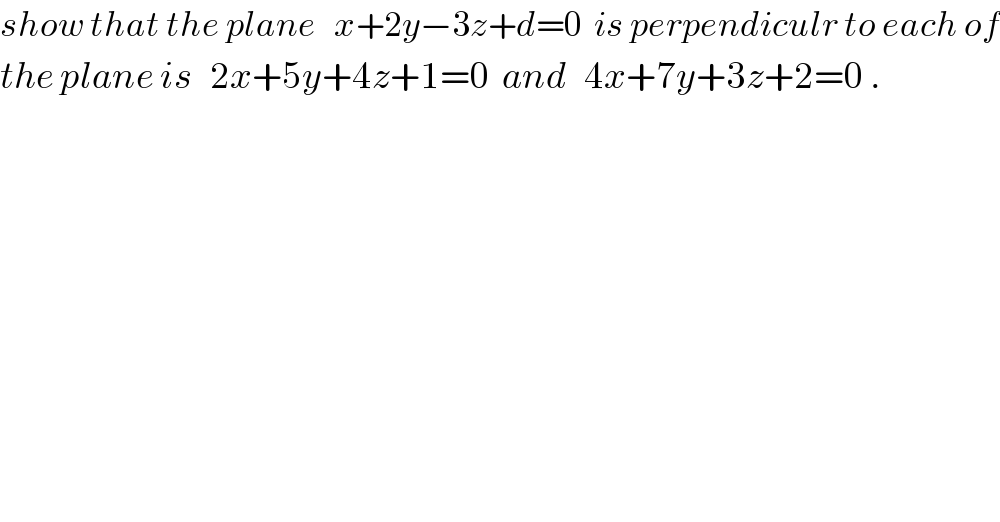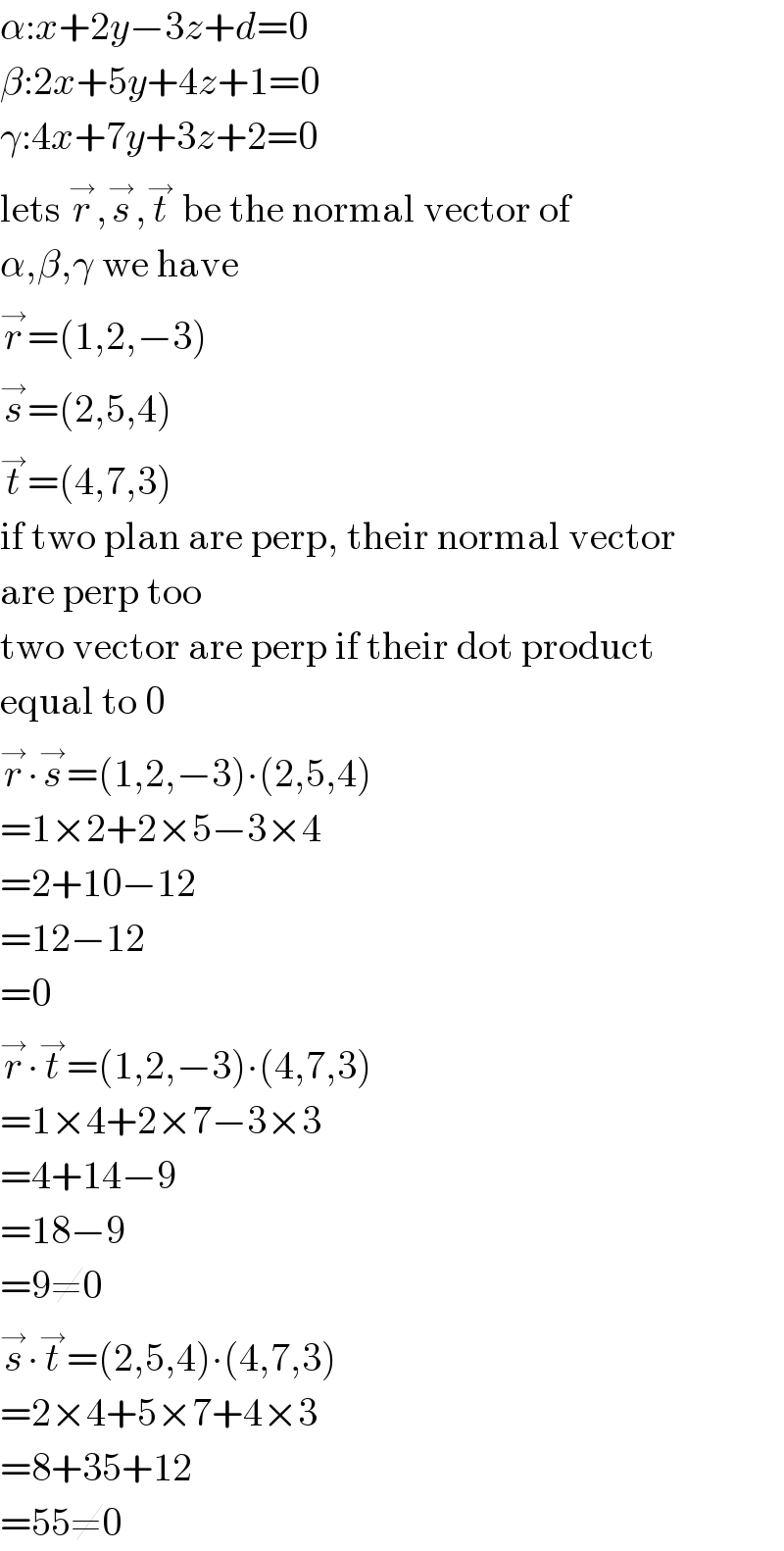
Question Number 8150 by trapti rathaur@ gmail.com last updated on 02/Oct/16

$${show}\:{that}\:{the}\:{plane}\:\:\:{x}+\mathrm{2}{y}−\mathrm{3}{z}+{d}=\mathrm{0}\:\:{is}\:{perpendiculr}\:{to}\:{each}\:{of} \\ $$$${the}\:{plane}\:{is}\:\:\:\mathrm{2}{x}+\mathrm{5}{y}+\mathrm{4}{z}+\mathrm{1}=\mathrm{0}\:\:{and}\:\:\:\mathrm{4}{x}+\mathrm{7}{y}+\mathrm{3}{z}+\mathrm{2}=\mathrm{0}\:.\: \\ $$
Commented by 123456 last updated on 03/Oct/16

$$\alpha:{x}+\mathrm{2}{y}−\mathrm{3}{z}+{d}=\mathrm{0} \\ $$$$\beta:\mathrm{2}{x}+\mathrm{5}{y}+\mathrm{4}{z}+\mathrm{1}=\mathrm{0} \\ $$$$\gamma:\mathrm{4}{x}+\mathrm{7}{y}+\mathrm{3}{z}+\mathrm{2}=\mathrm{0} \\ $$$$\mathrm{lets}\:\overset{\rightarrow} {{r}},\overset{\rightarrow} {{s}},\overset{\rightarrow} {{t}}\:\mathrm{be}\:\mathrm{the}\:\mathrm{normal}\:\mathrm{vector}\:\mathrm{of}\: \\ $$$$\alpha,\beta,\gamma\:\mathrm{we}\:\mathrm{have} \\ $$$$\overset{\rightarrow} {{r}}=\left(\mathrm{1},\mathrm{2},−\mathrm{3}\right) \\ $$$$\overset{\rightarrow} {{s}}=\left(\mathrm{2},\mathrm{5},\mathrm{4}\right) \\ $$$$\overset{\rightarrow} {{t}}=\left(\mathrm{4},\mathrm{7},\mathrm{3}\right) \\ $$$$\mathrm{if}\:\mathrm{two}\:\mathrm{plan}\:\mathrm{are}\:\mathrm{perp},\:\mathrm{their}\:\mathrm{normal}\:\mathrm{vector} \\ $$$$\mathrm{are}\:\mathrm{perp}\:\mathrm{too} \\ $$$$\mathrm{two}\:\mathrm{vector}\:\mathrm{are}\:\mathrm{perp}\:\mathrm{if}\:\mathrm{their}\:\mathrm{dot}\:\mathrm{product} \\ $$$$\mathrm{equal}\:\mathrm{to}\:\mathrm{0} \\ $$$$\overset{\rightarrow} {{r}}\centerdot\overset{\rightarrow} {{s}}=\left(\mathrm{1},\mathrm{2},−\mathrm{3}\right)\centerdot\left(\mathrm{2},\mathrm{5},\mathrm{4}\right) \\ $$$$=\mathrm{1}×\mathrm{2}+\mathrm{2}×\mathrm{5}−\mathrm{3}×\mathrm{4} \\ $$$$=\mathrm{2}+\mathrm{10}−\mathrm{12} \\ $$$$=\mathrm{12}−\mathrm{12} \\ $$$$=\mathrm{0} \\ $$$$\overset{\rightarrow} {{r}}\centerdot\overset{\rightarrow} {{t}}=\left(\mathrm{1},\mathrm{2},−\mathrm{3}\right)\centerdot\left(\mathrm{4},\mathrm{7},\mathrm{3}\right) \\ $$$$=\mathrm{1}×\mathrm{4}+\mathrm{2}×\mathrm{7}−\mathrm{3}×\mathrm{3} \\ $$$$=\mathrm{4}+\mathrm{14}−\mathrm{9} \\ $$$$=\mathrm{18}−\mathrm{9} \\ $$$$=\mathrm{9}\neq\mathrm{0} \\ $$$$\overset{\rightarrow} {{s}}\centerdot\overset{\rightarrow} {{t}}=\left(\mathrm{2},\mathrm{5},\mathrm{4}\right)\centerdot\left(\mathrm{4},\mathrm{7},\mathrm{3}\right) \\ $$$$=\mathrm{2}×\mathrm{4}+\mathrm{5}×\mathrm{7}+\mathrm{4}×\mathrm{3} \\ $$$$=\mathrm{8}+\mathrm{35}+\mathrm{12} \\ $$$$=\mathrm{55}\neq\mathrm{0} \\ $$
